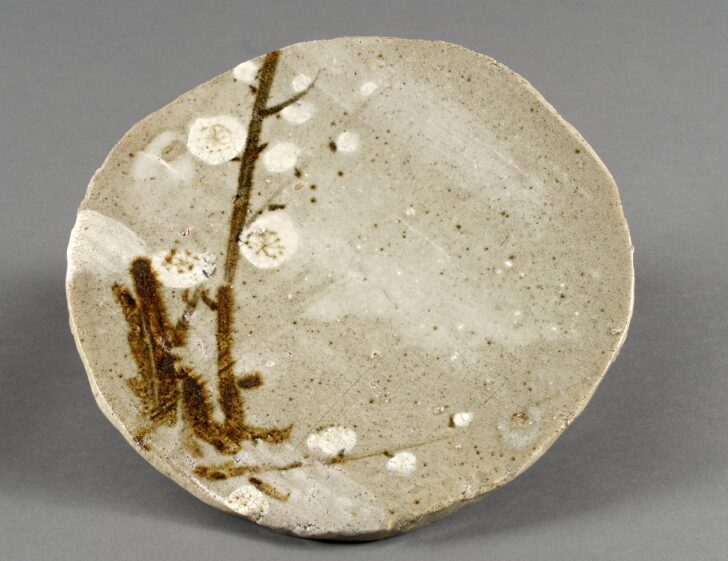Plate with white plum blossom design
Arakawa Toyozô

Description
Arakawa Toyozô
Japan, 1894–1985
Plate
Showa period (1926–1989)
circa 1960
Stoneware with iron glaze and white slip painting
Gift of the artist, 1963/2.64
Arakawa Toyozô was instrumental in reviving the materials and firing method of Shino, a late-sixteenth-century Momoyama ware. Arakawa’s masterful application of the ware’s characteristic thick, milky glaze and iron underglaze painting is the signature of his work. This robust plate was fired in the tall noborigama (climbing kiln) that Arakawa built in the town of Minazuki in order to achieve the extremely high temperatures required for overglaze-painted stoneware. To create the irregular yet whimsical rim, a wire was used to cut a flat clay slab and the edge was then slightly lifted up.
(Turning Point exhibition, Spring 2010)
The esteemed potter Arakawa Toyozô was instrumental in reviving the materials and firing method of Shino, the late-sixteenth-century Momoyama ware. Arakawa’s masterful application of the ware’s typical thick, milky glaze and iron underglaze painting is the great signature of his work. The Japanese government honored Arakawa with the designation “National Treasure” in the 1950s.
This robust plate was fired in the tall Minazuki noborigama (climbing kiln) that Arakawa built for achieving the extremely high temperatures required for firing overglaze-painted stoneware. To create the irregular yet whimsical rim, a wire was used to cut a flat clay slab; the edge was then slightly lifted up.
(Label for UMMA Japanese Gallery Opening Rotation, March 2009)
---
Arakawa Toyozô was instrumental in reviving the materials and firing method of Shino, a late-sixteenth-century Momoyama ware. Arakawa’s masterful application of the ware’s characteristic thick, milky glaze and iron underglaze painting is the signature of his work. This robust plate was fired in the tall noborigama (climbing kiln) that Arakawa built in the town of Minazuki in order to achieve the extremely high temperatures required for overglaze-painted stoneware. To create the irregular yet whimsical rim, a wire was used to cut a flat clay slab and the edge was then slightly lifted up.
(Turning Point exhibition, Spring 2010)
Subject Matter:
The plum tree has white blossoms. The plate is intended for serving sweets or food in tea ceremony.
Physical Description:
It is a round, stoneware plate. Clay is red covered with mottled grayish glaze and painted with underglaze iron and white slip. Imperfection of clay was resulted in occasional bumps on surface. Six spur marks are visible on the bottom. Slab is roughly cut (deliberately); the plate is in slightly convex shape. Artist’s seal with underglaze iron appears on the bottom.
Usage Rights:
If you are interested in using an image for a publication, please visit https://umma.umich.edu/request-image/ for more information and to fill out the online Image Rights and Reproductions Request Form.